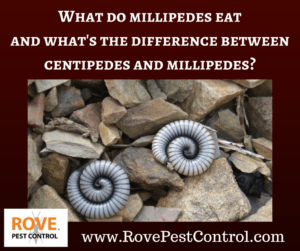There’s a lot of confusion around what’s the difference between centipedes and millipedes and if millipedes are dangerous and what do millipedes eat, so in this post we clear some of that up. 
What’s the difference between a millipede and a centipede
While centipedes and millipedes might look very similar to the untrained eye, there are many differences that can help you distinguish them from each other. One key characteristic of centipedes, for example, is that they are usually generally flat, while millipedes are more cylindrical in shape.
The amount of legs per segment is another way to tell the difference between millipedes and centipedes. Centipedes only have one pair of legs per body segment, whereas millipedes have two pairs of legs per segment.
You would think then that millipedes would be faster since they have more legs, but the reverse is actually true. Most millipedes move slowly in comparison to centipedes, so those extra legs don’t do much to help in the speed department.
Offense VS Defense and centipedes vs millipedes
Another thing that factors into the question of what do millipedes eat and the difference between centipedes and millipedes is how they feed. Centipedes are aggressive and prefer to attack their prey.
Centipedes go on the offensive with a couple of modified legs called maxillipeds. They can inject venom from these “legs” and use them offensively as they are carnivores and eat other insects and some pests.
Even though centipedes rarely will bite humans, they can, but it would be similar in pain to that of a bee sting. Millipedes on the other hand are not aggressive creatures nor do they attack humans. Millipedes prefer defense and typically cower from danger and predators.
When it comes to what millipedes eat, they focus more on feeding on decaying matter. This could be rotting flesh, plants, dead insects, and sometimes small plants.
Millipedes tend to curl up in a ball as a defensive mechanism against predators and can even secrete defensive juices to protect themselves and ward off predators as well.
Millipedes and centipedes are environmentally friendly
Both millipedes and centipedes are probably not something you want to have around your home, but they both do some good for the environment. Since centipedes do feed off of other insects, they can help combat pest issues on a small scale.
Of course, if you are seeing lots of centipedes around your home, that usually means they do have an ample food source for them to feed from. If that’s the case, you probably have other pest issues you might want to have checked out by a pest control service.
Millipedes on the other hand aren’t usually found too often inside your home, but they can definitely be out and about around the outside of your home. Millipedes typically will live under rocks, rotting logs, leave piles, in gardens, and in tall grasses. If you are finding millipedes inside of your home, adjustments to address the moisture issue will help resolve their presence.
Since they do feed from decaying matter it’s best not to directly touch them with your bare hands and if you do, be sure to wash them soon after to decrease any risk of spreading disease or germs.
At the same time, since millipedes do feed from decaying matter, they play an important role in the ecosystem. They can help speed up the soil fertilization process by helping with the decomposition of plants and animals faster than they normally would on their own.
Did This Blog Help You? We would greatly appreciate if you could comment below and share on Facebook
Have a question for us? Be sure to reach out on Facebook: www.facebook.com/RoveMinnesota
P.S. Have a pest issue? As a first time customer with Rove Pest Control – Click Here to get $50 off your initial service!
Did you get value from this post on, What do millipedes eat and what’s the difference between centipedes and millipedes, please retweet below!
